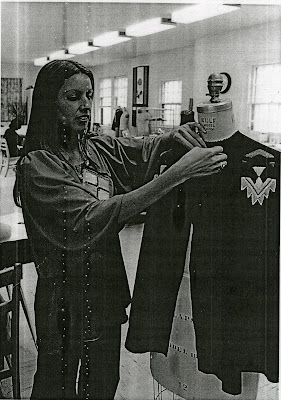“I didn’t really know what Native American traditions were. I had always loved beading as a young girl – really loved it – but it was many years later that I discovered it was part of my cultural heritage – as a Native American and as a Native American woman. It was a powerful discovery.” – Wendy Ponca, 2000
Kimberly ‘Wendy’ Ponca (Osage) has been described as an Osage avant-garde, but also as an artist who continues the legacy of the traditional Osage figure Spider Woman, who, according to tribal stories, taught weaving to the people. She once stated, “Many people do art for money. Others do art for arts sake. I do art for history’s sake. I want to preserve my traditional culture, while reflecting the signs of contemporary America.” Ponca maintained key elements of her Osage traditions by re-presenting them and expressing them through new materials, rendering them compatible with contemporary society.
 (Wendy Ponca as the Fashion Instructor at IAIA)
(Wendy Ponca as the Fashion Instructor at IAIA)Ponca was the main fashion instructor at the Institute of American Indian Arts for a decade between 1983 and 1993, and she was instrumental in making Native fashion what it is today. Her educational background was in clothing and textile design, and she combined this knowledge with stimulating art curriculum and Native American culture studies. She explained that her courses at IAIA “transcend the normal art school curriculum in that, as Indians, we are furthering tradition. As we evolve culturally within a multi-cultured environment, we are doing and creating as we have for hundreds… even thousands… of years; utilizing that which surrounds us symbolically, economically, and fashionably.”

(Wendy Ponca's motorcycle blanket)
To create her wearable art, Ponca drew on her experiences as a contemporary Osage person, and this is evident in her juxtaposition of the time-honored with the entirely-new. Her garment collections have been described as both a reflection and a redefinition of a culture. Ponca’s clothing and fashion shows deconstruct stereotypes, present theories of female beauty and power, impart Osage oral tradition and cosmological beliefs, and champion fashion as art.
 (Wendy Ponca coat made with Rainbow Selvedge Wool Broadcloth)
(Wendy Ponca coat made with Rainbow Selvedge Wool Broadcloth)As a designer, Ponca used innovative new materials for her clothing designs to tell traditional Osage stories. For example, she incorporated Mylar, a synthetic material used on space shuttles, which she conceptualized as connected with the sky and stars. Ponca perceived these qualities as compatible with Osage cosmological beliefs. Traditional Osage stories communicate a deep connection that exists between the earth people and the sky world, since the Osage believe that their ancestors came from the sky. To Ponca, the use of Mylar accentuated the wearer’s relationship with the sky.
 (Wendy Ponca's dress designs. Dress on right features the important Osage spider symbol)
(Wendy Ponca's dress designs. Dress on right features the important Osage spider symbol)
Ponca also painted tattoos onto her female models’ bodies and adorned their hair with feathers for photographs and fashion shows. As Ponca explained, she used body paint and feathers because of the strength that it bestows the wearer. Ponca stated that the body art and feathers “changes you on the inside, your intellect, being. It’s a powerful thing, it changes you emotionally." This way of thinking directly related to her philosophy concerning garments and adornment: what you wear should convey identity, confidence and a tribally-informed sense of beauty. Other designers such as Pilar Agoyo and Virgil Ortiz have recently used similar body adornment in their shows and fashion shoots.

(Native Uprising designer collective, Santa Fe, 1988)
Importantly, in the mid-1980s Ponca co-founded the Native Influx (later, Native Uprising) collective of designers, models, and artists, which was the first group of its kind – effectively establishing Santa Fe as the center for Native American haute couture. Furthermore, because of the innovations of this group, the Santa Fe Indian Market added new categories for judging clothing and paved the pathway to create a new market venue for Native clothing designers.
As IAIA’s main fashion instructor, Ponca undoubtedly greatly influenced her students’ work and the contemporary Native American fashion world.
(Note: This is an excerpt from my dissertation and is copyrighted material)
(All images courtesy of Wendy Ponca)

